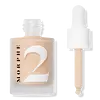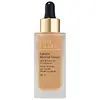What's inside
What's inside
 Key Ingredients
Key Ingredients

 Benefits
Benefits

 Concerns
Concerns

 Ingredients Side-by-side
Ingredients Side-by-side

Water
Skin ConditioningIsododecane
EmollientGlycerin
HumectantPhenyl Trimethicone
Skin ConditioningTrisiloxane
Skin ConditioningCetyl PEG/PPG-10/1 Dimethicone
EmulsifyingDimethicone
EmollientPEG-10 Dimethicone
Skin ConditioningButylene Glycol
HumectantSodium Chloride
MaskingPhenoxyethanol
PreservativeDimethiconol
EmollientMethicone
EmollientPotassium Sorbate
PreservativeSodium Dehydroacetate
PreservativeTalc
AbrasiveHydrogen Dimethicone
CI 77891
Cosmetic ColorantIron Oxides
Ethylhexyl Methoxycinnamate 6.7%
UV AbsorberEthylhexyl Salicylate 4.5%
UV AbsorberZinc Oxide 6.8%
Cosmetic ColorantWater
Skin ConditioningTrimethylolpropane Tricaprylate/Tricaprate
EmollientGlycerin
HumectantButylene Glycol
HumectantButyloctyl Salicylate
Skin ConditioningCaprylic/Capric Triglyceride
MaskingSilica
AbrasivePolyglyceryl-10 Oleate
Skin ConditioningBentonite
AbsorbentSaccharide Isomerate
HumectantTocopheryl Acetate
AntioxidantAcetyl Glucosamine
Skin ConditioningLimnanthes Alba Seed Oil
Skin ConditioningGlyceryl Hydrogenated Rosinate
Rosa Canina Fruit Oil
EmollientTrametes Versicolor Extract
Yeast Extract
Skin ConditioningGlycine Soja Oil
EmollientPropylene Glycol Dicaprate
EmollientHelianthus Annuus Seed Extract
Skin ConditioningGlycine Soja Seed Extract
Skin ConditioningHordeum Vulgare Extract
EmollientCalendula Officinalis Flower Extract
MaskingCucumis Sativus Fruit Extract
EmollientCaprylyl Glycol
EmollientCholesterol
EmollientSodium Stearoyl Glutamate
CleansingAlgin
MaskingXanthan Gum
EmulsifyingSodium Chloride
MaskingAluminum Hydroxide
EmollientPolyhydroxystearic Acid
EmulsifyingBHT
AntioxidantCitric Acid
BufferingSodium Citrate
BufferingPotassium Sorbate
PreservativePhenoxyethanol
PreservativeCI 77891
Cosmetic ColorantCI 77491
Cosmetic ColorantCI 77492
Cosmetic ColorantCI 77499
Cosmetic ColorantEthylhexyl Methoxycinnamate 6.7%, Ethylhexyl Salicylate 4.5%, Zinc Oxide 6.8%, Water, Trimethylolpropane Tricaprylate/Tricaprate, Glycerin, Butylene Glycol, Butyloctyl Salicylate, Caprylic/Capric Triglyceride, Silica, Polyglyceryl-10 Oleate, Bentonite, Saccharide Isomerate, Tocopheryl Acetate, Acetyl Glucosamine, Limnanthes Alba Seed Oil, Glyceryl Hydrogenated Rosinate, Rosa Canina Fruit Oil, Trametes Versicolor Extract, Yeast Extract, Glycine Soja Oil, Propylene Glycol Dicaprate, Helianthus Annuus Seed Extract, Glycine Soja Seed Extract, Hordeum Vulgare Extract, Calendula Officinalis Flower Extract, Cucumis Sativus Fruit Extract, Caprylyl Glycol, Cholesterol, Sodium Stearoyl Glutamate, Algin, Xanthan Gum, Sodium Chloride, Aluminum Hydroxide, Polyhydroxystearic Acid, BHT, Citric Acid, Sodium Citrate, Potassium Sorbate, Phenoxyethanol, CI 77891, CI 77491, CI 77492, CI 77499
 Reviews
Reviews

Ingredients Explained
These ingredients are found in both products.
Ingredients higher up in an ingredient list are typically present in a larger amount.
Butylene Glycol (or BG) is used within cosmetic products for a few different reasons:
Overall, Butylene Glycol is a safe and well-rounded ingredient that works well with other ingredients.
Though this ingredient works well with most skin types, some people with sensitive skin may experience a reaction such as allergic rashes, closed comedones, or itchiness.
Learn more about Butylene GlycolCi 77891 is a white pigment from Titanium dioxide. It is naturally found in minerals such as rutile and ilmenite.
It's main function is to add a white color to cosmetics. It can also be mixed with other colors to create different shades.
Ci 77891 is commonly found in sunscreens due to its ability to block UV rays.
Learn more about CI 77891Glycerin is already naturally found in your skin. It helps moisturize and protect your skin.
A study from 2016 found glycerin to be more effective as a humectant than AHAs and hyaluronic acid.
As a humectant, it helps the skin stay hydrated by pulling moisture to your skin. The low molecular weight of glycerin allows it to pull moisture into the deeper layers of your skin.
Hydrated skin improves your skin barrier; Your skin barrier helps protect against irritants and bacteria.
Glycerin has also been found to have antimicrobial and antiviral properties. Due to these properties, glycerin is often used in wound and burn treatments.
In cosmetics, glycerin is usually derived from plants such as soybean or palm. However, it can also be sourced from animals, such as tallow or animal fat.
This ingredient is organic, colorless, odorless, and non-toxic.
Glycerin is the name for this ingredient in American English. British English uses Glycerol/Glycerine.
Learn more about GlycerinPhenoxyethanol is a preservative that has germicide, antimicrobial, and aromatic properties. Studies show that phenoxyethanol can prevent microbial growth. By itself, it has a scent that is similar to that of a rose.
It's often used in formulations along with Caprylyl Glycol to preserve the shelf life of products.
Potassium Sorbate is a preservative used to prevent yeast and mold in products. It is commonly found in both cosmetic and food products.
This ingredient comes from potassium salt derived from sorbic acid. Sorbic acid is a natural antibiotic and effective against fungus.
Both potassium sorbate and sorbic acid can be found in baked goods, cheeses, dried meats, dried fruit, ice cream, pickles, wine, yogurt, and more.
You'll often find this ingredient used with other preservatives.
Learn more about Potassium SorbateChances are, you eat sodium chloride every day. Sodium Chloride is also known as table salt.
This ingredient has many purposes in skincare: thickener, emulsifier, and exfoliator.
You'll most likely find this ingredient in cleansers where it is used to create a gel-like texture. As an emulsifier, it also prevents ingredients from separating.
There is much debate on whether this ingredient is comedogenic. The short answer - comedogenic ratings don't tell the whole story. Learn more about comegodenic ratings here.
The concensus about this ingredient causing acne seems to be divided. Research is needed to understand if this ingredient does cause acne.
Scrubs may use salt as the primary exfoliating ingredient.
Learn more about Sodium ChlorideWater. It's the most common cosmetic ingredient of all. You'll usually see it at the top of ingredient lists, meaning that it makes up the largest part of the product.
So why is it so popular? Water most often acts as a solvent - this means that it helps dissolve other ingredients into the formulation.
You'll also recognize water as that liquid we all need to stay alive. If you see this, drink a glass of water. Stay hydrated!
Learn more about Water